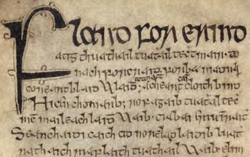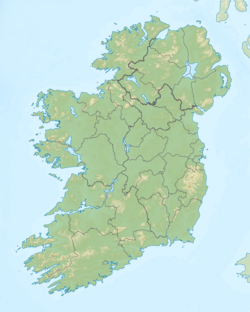"Book of Lecan" redirects here. Not to be confused with the Yellow Book of Lecan, an earlier manuscript.
| Leabhar Mór Leacain | |
|---|---|
| Royal Irish Academy (302 leaves) Trinity College Library | |
 Opening lines of Máel Mura Othna's poem "Flann for Érinn" ("Flann over Ireland"), from the Great Book of Lecan, 296v Opening lines of Máel Mura Othna's poem "Flann for Érinn" ("Flann over Ireland"), from the Great Book of Lecan, 296v | |
| Also known as | Leabhar Lecain, Great Book of Lecan, Book of Lecan |
| Type | Compilation of Irish legends |
| Date | Between 1397 and 1418 |
| Place of origin | Clonmacnoise |
| Language(s) | Middle Irish |
| Scribe(s) | Giolla Íosa Mór Mac Fhirbhisigh, Ádhamh Ó Cuirnín |
| Material | Vellum |
| Size | 32cm x 22cm |
| Format | Folio |
| Condition | Pages covered in greasy material |
| Script | Irish minuscule |
| Contents | Legends, genealogy, history, hagiography |

The Great Book of Lecan or simply Book of Lecan (Irish: Leabhar (Mór) Leacáin) (RIA, Ms. 23 P 2) is a late-medieval Irish manuscript written between 1397 and 1418 in Castle Forbes, Lecan (Lackan, Leckan; Irish Leacán), in the territory of Tír Fhíacrach, near modern Enniscrone, County Sligo. It is in the possession of the Royal Irish Academy. Nollaig Ó Muraile dated it to c. 1397–1432 or possibly even a little later. Another estimate dated it to the early 15th century.
Leabhar Mór Leacáin is written in Middle Irish and was created by Ádhamh Ó Cuirnín, Murchadh Ó Cuindlis, and an anonymous third scribe for Giolla Íosa Mór Mac Fhirbhisigh. The material within was transcribed from the Book of Leinster, latter copies of the Book of Invasions, the Dinsenchas, the Banshenchas, and the Book of Rights.
At one stage it was owned by James Ussher. After it was seized from Trinity College Dublin by troops under the command of Sir John Fitzgerald, 2nd Baronet, in 1689 during the Williamite War in Ireland, James II of England deposited it at the Irish College, Paris. In 1787, the Chevalier O'Reilly returned it to Ireland, where it was at one stage in the possession of Charles Vallancey, who passed it on to the Royal Irish Academy.
There were originally 30 folios; the first nine were apparently lost in 1724. These contained a large section devoted to the pedigrees and history of the Norse and Norse–Gaelic families of Ireland, which are nowhere else preserved.
The pages are covered in a greasy substance which makes them transparent and reduces their legibility.
See also
External links
- Irish Script on Screen has a facsimile
References
- Welch, Robert (2000). The Concise Oxford Companion to Irish Literature. Oxford University Press. p. 34. ISBN 9780192800800.
- ^ Jones, Mary (2004). "The Great Book of Lecan". Jones' Celtic Encyclopedia.
- ^ Farry, Neal (23 July 2020). "The Book of Ballymote: Codices Hibernenses Eximii - II - Edited by Ruairí Ó hUiginn". The Corran Herald (52: 2019/2020): 17 – via Issu. Cites both Ó hUiginn and Nollaig Ó Muraile.
- Sellar, W. D. H. (October 1966). "The Origins and Ancestry of Somerled". The Scottish Historical Review. 45 (140): 125. JSTOR 25528658.
- Calder, George. Färber, Beatrix (ed.). "The Scholar's Primer". CELT: Corpus of Electronic Texts. University College, Cork. Retrieved 31 December 2021.
- Bergin, John (October 2009). "Fitzgerald, Sir John". Dictionary of Irish Biography. Dublin: Royal Irish Academy. Retrieved 1 February 2023.
- Cusack, Mary Frances (1875) . An Illustrated History of Ireland from AD 400 to 1800 (New & enlarged ed.). Kenmare Publications. p. 50 – via Google Books.
- Mac Firbis, Duald (1905). On the Fomorians and the Norsemen. Translated by Bugge, Alexander. Christiania, Norway: J. Chr. Gundersens Bogtrykkeri. See Bugge's introduction.
| Medieval Irish language manuscripts | |
|---|---|
| in the library of the Royal Irish Academy | |
| in the library at Trinity College Dublin | |
| in the Bodleian Library, Oxford | |
| in the British Museum | |
| in the University College Dublin Library | |
| in the Boole library at University College Cork | |
| See also Early Irish literature | |
This article about a manuscript is a stub. You can help Misplaced Pages by expanding it. |